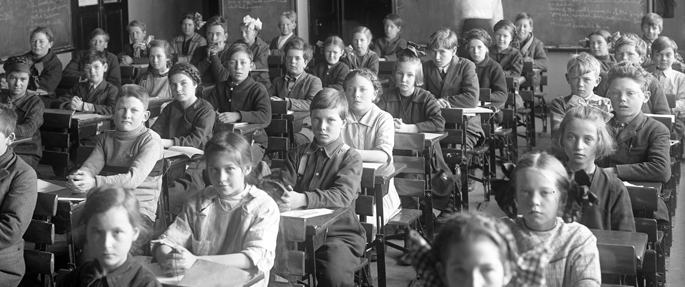At TNTP, one of the things we find frustrating about education policy debates is the degree to which they become polarized and oversimplified. Take the flashpoint issue of class size. You can believe that small class sizes are generally a good thing at the same time that you believe that lowering class sizes indiscriminately is not a practical or cost-effective way to improve schools (as the existing research strongly suggests). But rarely will you see such nuances reflected in arguments over policy.
As an organization of several hundred independent-minded professionals, including plenty of parents and former teachers, we wrestle with these sorts of complexities every day. On the class size issue, specifically, we take the position that absurd, unmanageable class sizes need to be dealt with, but a narrow focus on lowering class sizes across the board can do as much harm as good. We’ve seen districts scrambling to hire more teachers—regardless of quality—to meet class size targets when they could have better served their students by hiring fewer, better teachers and giving them good supports.
That doesn’t mean that we don’t have different perspectives on the issue, however. We do our best to celebrate diversity of thought. Today, we asked two of our team members to give us their personal take on class size, as an example of how we sometimes knock heads in the most polite sort of way.
Class Size Isn’t the Hill to Die On
By Dan Weisberg
There are lots of reasons all my friends care about class size more than anything else when they are assessing school options for their children. Some I think are totally valid (my kid is going into kindergarten and is very shy so needs lots of one-on-one time), some less so (in a class of 30, kids are going to be fooling around the whole time).
Research tells us that teacher effectiveness matters a lot more than class size, but making that argument to my friends, as I sometimes do, is misplaced energy and futile besides—I’m arguing against what looks like common sense. “Of course it’s better for my kid to be in a class with 22 kids than 28 kids. It’s simple, it’s easy to measure, and it’s there, right in front of our eyes!”
Parents focus on class size not because they’re illogical, but because the current system hasn’t been able to show them that there are different models that will work. Twenty-five years ago you could argue to an IT manager that he or she should scrap desktop computers because portable computers would make employees more productive and they’d throw you out of their office (even though you would have been right). Once Dell started mass-producing laptops for big businesses, IT managers shifted away from desktops very quickly.
In K-12 education right now, we can’t show parents any education models beyond the one we’ve been using for 150 years—one teacher in a box lecturing to a bunch of kids. Imagine how the conversation would change if you could show parents school designs with fewer teachers per student, but where students get a much richer experience and end up achieving at higher rates. I’m talking about schools where teachers are highly paid professionals, responsible for helping each of their (many) students meet learning standards, and where teachers direct teams of support staff to facilitate online learning, one-on-one tutoring and group instruction.
There are only a tiny number of examples of this in the United States, not enough to make a dent. Nearly all the great district and charter schools beating the odds for poor kids and kids of color are using the traditional model—they also put a teacher in a box with a group of kids, they just have much higher-performing teachers and leaders and better paint jobs. The market for computers wouldn’t have changed if Dell had been able to produce 38 laptops a year.
So I’ve started to use a different argument with friends: instead of demanding that your principal use part of a shrinking budget to maintain class sizes of 24 (avoiding having them “balloon” to 26), why aren’t you demanding that kids get access to all the great content on the web as a core part of their education? Or that you and your kids can communicate with teachers using those newfangled inventions, texts and email? Do you really want dollars spent on maintaining a steady head count, or do you want them spent on finding ways to evolve a 19th century model of education?
Class Size Matters More Than We Think
By Victoria Van Cleef
As a parent, class size is one of those areas where I trust my gut over what the research says. And as someone who works on the implementation side of policy, I believe that we don’t have a true measure of the effect of class size, because I can assure you no district has ever implemented these reduction efforts well.
Hiring teachers is among the most important things schools do—but hiring aimed at reducing class sizes usually happens under the least helpful conditions. We all know when the funding for these initiatives rolls out (July) and when teachers get hired for these reduction efforts (August), and then we wonder why we have no results to show for the money. It shouldn’t be a mystery; we’ve long known that late hiring drives top candidates away.
I don’t want to see larger class sizes as a policy solution for dealing with our budget crisis or for giving more kids access to our top-tier teachers. I think we must do better than that. Take Clark County, Nevada, as an example. As Superintendent Pat Skorkowsky recently wrote, “The Clark County School District has some of the largest class sizes in the nation…The average classroom has 40 students. This average class includes: 23 students from low-income homes, seven special needs students who require an individualized education program, seven students who do not speak English at home and two students identified as homeless.”
Right now, Las Vegas schools have 2,000 vacancies and no significant applicant pool chomping at the bit to take on that challenge. To ask the current population of talented teachers to meet the individuals needs of that large and diverse a population of students feels like a recipe for burnout—or at minimum, a recipe for watering down the effect of that teacher talent.
I have two kids, one who is a behavior challenge and demands more time from his teacher, and one who is several grade levels ahead in math and needs to have his learning accelerated. Differentiating instruction, like what I know is necessary to meet my kids’ needs, is one of the highest-order skills teachers possess. As it is, we don’t see it done well very often. I believe larger class sizes will tax the highest-order skills that only the best of the best do well. While I agree that more kids need access to our best teachers, I believe we need to find more creative solutions. Ones that don’t interfere with a teacher’s ability to connect with each child in his or her class.
I have to agree with Pat that “when class sizes are smaller, it makes it easier to personalize instruction and form relationships with students. When that happens, better student engagement and performance are not far behind.” Take the research on small schools, for instance: while it failed to show significant gains in student outcomes, it did show dramatic gains in things like reduction in violence and increase in graduation rates. Imagine if those small schools did performance management well, used evaluation to drive improvements in instruction and professional development and made critical decisions based on their data. I’d like to see their results then.









